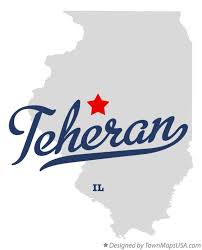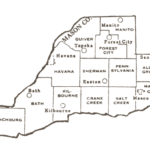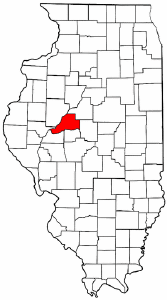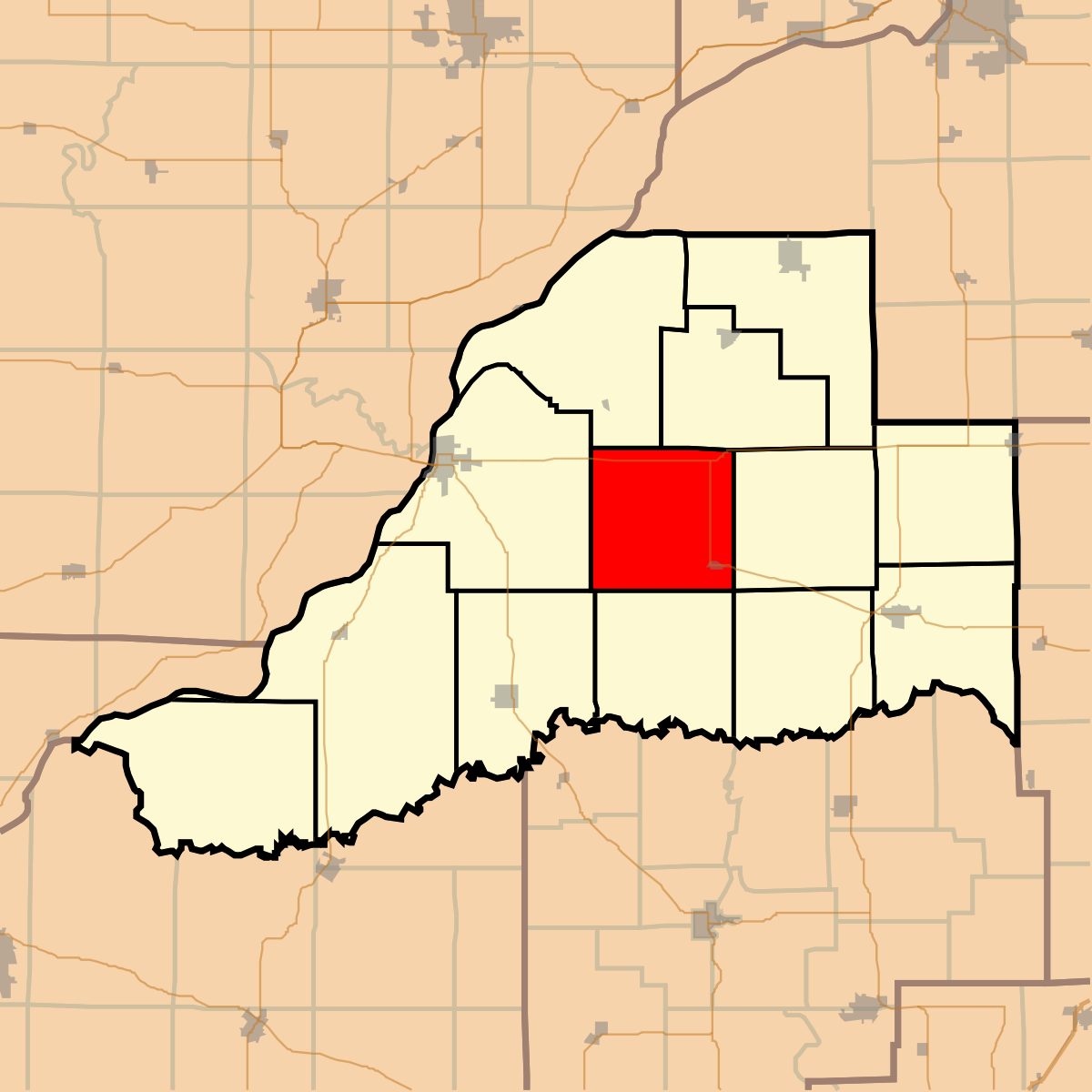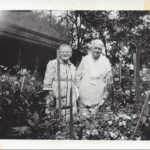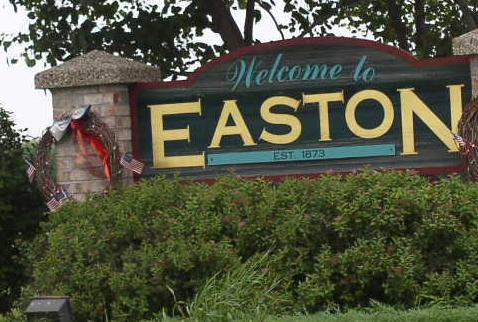Upcoming Schedule
March 2-6- Salt Creek Township
March 9-13- Forest City Township
March 16- 20- Quiver Township
March 23-27- Manito Township
March 30-April 3- Lynchburg Township
April 6-10- Bath Township
April 13-17- Kilbourne Township
April 20-30 Mason City Township
May 4-8- Allen’s Grove
May 11-22- Havana Township
BIOGRAPHICAL SKETCHES- PENNSYLVANIA TOWNSHIP
DAVID E. CRUSE, farmer and stock-raiser; P. 0. Teheran ; was born in Huntingdon Co., Penn , Nov. 1, 1833; his father, Augustus, was born in Cumberland Co. Penn., and married Elizabeth Rench ; they reside in Miami Co., Ohio, and have eight chil- dren living Joseph R., Lena M.,’David E., Luther C., Cinderella, George W., Demetrius A. and Roxanna N. In 1839, the family moved to Ohio ; David E. Cruse moved to Mason Co., where they now reside, in September, 1855, and married Hannah Touilin Nov. 30, 1856; she was born in Cumberland Co., N. J., Dec. 21, 1838, and came to Mason Co. with her parents in 1854. Mr. C. has been School Director most of the time, the last seventeen years, in Pennsylvania Township. They have had ton children Cinderella, born July 27, 1857, died Oct. 5, following; Caroline W., born Oct. 3, 1858 ; Matthew A., Feb. 1 1 , 1860 ; Hannah E., June 29, 1863 ; Margaret M., May 1, 1865; lloxanna B., July 4. 1867; David S., Feb. 1, 1869 ; John S., Jan. 7, 1871 ; Oraella, Jan. 18, 1873, and George I., Jan. 21, 1878. Mrs. Cruse’s father, Matthew Tomlin, was boro in Cumberland Co., N. J., May 30, 1803, and married Hannah Homer, of the same place ; he died in Mason Co. Feb. 22, 1873; she died Dec; 1, 1878, in the same place. Mr. Cruse owns a well-improved farm of 160 acres. ID politics, he is a Democrat.
ANDREW J. GATES, grain merchant, farmer and stock-raiser, Teheran ; was born near Hillsboro, Coffee Co., Tcnn., Sept. 28, 1833 ; came to Jefferson Co., 111., with his parents, in 1834 ; they moved to Greene Co., Mo., the same year, remaining two years, then moved Hamilton Co., 111., where his parents remained; his father, James L., was. born in Alabama Aug. 14, 1809, and married Nancy Shelton Jan. 7, 1831 ; she was born in Virginia Jan. 9, 1808. He died Aug. 10, 1846 ; she, Oct. 3, 1876. A. J. Gates, the subject of this sketch, came to Mason Co. Oct. 16, 1854, but spent the next winter in Fulton Co.; the next fall, commenced farming, and has followed the business ever since; he bought land in Pennsylvania Township, where he now resides, in 1858, near Teheran. In 1874, was elected Justice of the Peace ; still officiates. ‘ August 24, 1855, he married Emily 0. Scovil, daughter of Pulaski Scovil, of Salt Creek Township ; she was born in Havana, Mason Co., Nov. 26, 1838. They have had twelve children Clara I., born Sept. 9, 1856 ; Anna A., Nov. 6, 1858 ; Mary E., Nov. 24, 1860 ; Lillie E., Nov. 14, 1862 ; William S., Feb. 10, 1865, died Nov. 21, 1866 ; Joseph A., born Feb. 8, 1867 ; Charles I., Feb. 17, 1869 ; Walter J., Feb. 13, 1871 ; Effie May, April 19, 1873; Olive A., April 3, 1875; Ada J.. May 3, 1877, and Jessie M., Jan. 20, 1879. He owns 249 acres of land, and a fine home and outbuildings in Teheran. In politics, he is a Republican.
MRS. MARY ANN DOLCATER, farming; P. 0. Easton ; widow of Henry E. Dolcater, deceased ; he was born in Bielsfield, Germany, Sept. 23, 1832, and came to this county in September, 1856, and settled in Mason Co., and followed farming and stock-raising until his decease, which occurred April 12, 1879. He married Mrs. Mary A. Samuell Aug. 23, 1859; she w.is bom in Sangamon Co., 111., Feb. 13, 1833; her father, William Pelham, was born in Connecticut Nov. 27, 1797, and married Almira Phelps, of the S;ime State; she was born Sept. 3, 1803; they moved to Illinois in 1824; she died Dec. 6, 18H4; he died Nov. 13, 1863. Mary Ann, the subject of this sketch, married (first husband) Thomas A. Samuell Aug. 23, 1856; he was born in Caroline Co., Va., March 1, 1807, and came to Illinois in 1835, from Kentucky; by this marriage was one boy William Thomas; he was born Oct. 1, 1857, and died Jan. 20, 1860. Henry E. Dolcater was elected in April, 1874, Supervisor, and served two years. Mr. and Mrs. Dolcater have five boys Henry C., born Aug. 23, 1861 ^ William C., Dec. 6, 1863; Franklin J., Aug. 25, 1865 ; Edward H., Oct. 11, 1867; Charles F., March 24, 1870. che owns 164 acres of fine prairie, and a beautiful home in Pennsylvania Township, where she resides.
HULDAU DORRELL, farming; P. 0. Easton; widow of Francis Dorrell, deceased; he was born in McKey.sport, Penn., Feb. 1, 1808. and moved to Hamilton Co., Ohio, with his parents, in 1H^2, and married Huldah Dcnman Feb. 23, 1832 ; she was born in Hamilton Co., Ohio, Sept. 30, 1806; her father, Nathaniel Denman, was born in New Jersey Aug. 29, 1780, and married Susanna Crow in June, 1802; she was born in Pennsylvania in 1782, and died Feb. 11, 1811 ; he died March 16, 1836, in Hamilton Co., Ohio. Mr. Dorrell was subject to heart disease and consumption, but was called to the sick-bed of his son, who was in the U. S. Army Hospital, at Bolivar, Tenn.; he arrived there only in time to close his eyes in death ; attended his funeral, and on his return, himself worn by excitement and overcome by grief, succumbed to the inevitable, in Havana, even before he reached his home ; they have had ei-ht children Susanna C., born Nov. 20,1832; Saiah H., Aug. 18, 1835; Mary A., Aug. 26, 1837 ; John M., Sept. 22, 1835 enlisted in the Federal army, in 1861, and died of camp disease, at Bolivar, Tenn., Dec. 6, 1862; Charles C., born Oct. 30, 1841 ; David D., Sept. 27, 1844 ; Rebecca, April 11, 1847. died April 5, following; Lauretta, born March 24, 1848, died July 5, following. Susanna C. married William C. Thompson in December, 1860; he was born in England Aug. 10, 1821, died July 29, 1873, in Wyoming Territory; they had four children Francis D., born Oct. 13,’ 1861 ; Caroline, Jan. 16, 1865, died Aug. 4, following; Andrew, born Aug. 23, 1867, died at the age of 3 weeks and 3 days; and Richard, born Aug. 15, 1872. Mrs. Dorrell owns 160 acres of excellent prairie land, of which she has been sole and successful manager since her husband’s decease now at the age of 73, in the possession of good health and remarkable vigor and wonderful memory of every event in her eventful life.
JOSEPH FINK, farmer and stock-raiser; P. 0. Teheran ; was born in Luzerne Co., Penn., June i3, 1832 ; except two years that he was employed clerking in a store, has followed farming ; he came to Pennsylvania Township, where he now resides, in 1856. He married Angeline Benscoter Dec. 2, 1855, in Luzerne Co., Penn., where she was born Aug. 4, 1836; her father, Jacob Benscoter, was born July 7, 1804, and married Jane Moss, in March, 1826; she was born April 2, 1807, and died July 1, 1866, in Mason City, where Mr. B. now resides. Mr. and Mrs. Fink have had nine children Walker B., born Dec. 7, 1856, and married Fannie Johnson Dec. 22, 1877, and moved to Kansas City July 15 ,1879 ; Emma L. J., born Sept. 22, 1858 ; Derie It., March 18, 1860; Porter H., Sept. 19, 1861; Lot, Nov. 22, 1863, died March 23, 1867; Harvey D., born Sept. 15, 1865; Jacob B., April 6, 1873; Arthur S., March 17, 1875, and Joseph M., Sept. 29, 1876. Mr. and Mrs. Fink are members of the M. E. Church, and the four eldest children of the Society of United Brethren. He owns a good farm of 125 acres good house and outbuildings.
ANDKEAS FURRER, farmer and stock -raiser; P. 0. Easton ; was born in Baden, Germany, Oct. 24, 1839; he landed in New Oilcans in June, and in Havana, Mason Co., July 3, 1853, with his parents ; he has made farming his business ; in 1863, bought eighty acres in Pennsylvania Township, where he now resides. Dec. 30, 1860, he married Mary Ann Dorrell ; she was born in Sangamon Co., 111., Aug. 26, 1837; she is a daughter of Francis and Iluldah Dorrell (see biography of Huldah Dorrell, widow). In June, 1876, Mr. Furrer concluded to take a vacation, by a grand excursion to the Centennial Exposition,, in Philadelphia, and a visit to his old home in Germany, visiting all the principal cities on the route, including Paris, the capital of France. On his return, Mrs. Furrer meeting him at Philadelphia, they visited points of interest on their return to the West ; they have six children Huldah D., born Dec. 11, 1861 ; John D., March 13, 1865; Nathaniel D., June 10, 1867; Sarah E., Dec. 5, 1869; Susanna C., June 22, 1872, and Francis D., Feb. 5, 1875. He owns 440 acres of land, and a fine house, barn and outbuildings.
JAMES I. HURLEY, firmer and stock-raiser; P. O.Teheran; was born in Ocean Co., N. J., June 11, 1836 ; there he followed the business of burning charcoal ; they moved to Mason Co., 111., in the fall of 1852 ; his father, Aaron Hurley, died on board a boat, on their Way West, with the cholera, and was buried on Liberty Island, just below St. Louis. (See biography of Christopher Titus.) After they came to Mason Co., Mr. James I. Hurley worked at farming by the month or day, until March 1861, when he purchased eighty acres of improved land, where he now resides, in Pennsylvania Township. He married Emma J. Riggs March 11, 1869 ; she was born in Orange Co., N. C., May 30, 1850, and came to Mason Co. Oct. 28, 1868; they have had seven children Maggie E., born Feb. 17, 1870 ; Sybil P., March 18, 1871 ; Olive M., May 29, 1872 (died July 18 following) ; Petro N., Oct. 25, 1873; Lena F., Sept. 12, 1874; Bertha V., Jan. 5, 1877; Royal E., June 8, 1878. He owns 140 acres of land, a good house and barn, and outbuildings, which he has erected since 1867.
JOHN W. PUGH, Supervisor, farmer and stock-raiser; P. 0. Mason City ; was born in Plymouth, Luzerne Co., P.enn., Aug. 5, 1824. His father owned a large farm, a grist and saw mill, which gave him plenty of miscellaneous and general employment while at home. lie moved to Mason Co. (Havana Township) in 1850 ; entered eighty acres of land that fall, in Section 27, Township 22, Range 7, and has since followed farming, mainly, though during the year of 1854, was captain of a boat running between Havana and Chicago, on the Illinois River. June 8, 1854, he married Miss Sarah Apple, daughter of Maj. Henry Apple, of Fulton Co., 111. She was born in Clermont Co., Ohio, Aug. 7, 1827. Mr. Pugh was elected Supervisor in April, 1866, and has held the office ever since, except two years that he was in the State Legislature, to which he was elected in November, 1874. They have had six children Henry A., born Feb. 22, 1855 ; Mary E., Nov. 21, 1856 ; Charles W., Sept. 7, 1859 ; George B., Oct 22, 1861 ; Clara E., April 19, 1864; John F., born July 29, 1867, died Aug. 26, 1868. He owns a fine home, and 343 acres of land. They belong to the Presbyterian Church. In politics, Mr. Pugh is a Democrat.
GEORGE W. SCOVILL, farmer and stock-raiser; P. 0. Mason City. “Yankee” was born in Litchfield Co., Conn., Oct. 31, 1837 ; moved to Adams Co., 111., in 1857 ; worked by the month for wages about four years ; he then returned to his old home, but returned, in August, to Mason Co., and leased 200 acres of new unbroken prairie, of Harvey Scovill, for five years. In 1865, he bought a farm, where he now resides. He married a daughter of Pulaski Scovil, of Salt Creek Township Mrs. Maria L. Paul, April 17, 1867. She was born in February, 1833, and married Thomas E. Paul Sept. 6, 1854, who was born Feb. 13, 1830, and died at Nashville, Tenn. (in the Federal army), of typhoid fever, Dec. 8, 1861. They had three children Sarah E., born May 9, 1856, died April 2, 1862 ; Fantley R., born April 6, 1858 ; Stephen A., born Dec. 25, 1860, died Dec. 25, 1862. Mr. George W. Scovill’s father, John W., was born in Litchfield Co., Conn., and married Martha Wilson, of the same county; died March 4, 1863. She resides on the old homestead, in Connecticut. After his father died, Mr. Scovill rented his farm out, and returned to farm a portion of the old homestead, but soon tired of his efforts to obtain wealth from the little earth distributed among the rocks of Connecticut, and gladly returned to his rural Western home. They have had four children George W., born Feb. 3, 1867 ; Mary L., born Feb. 14, 1869, died Au2. 17, 1872 ; Addie L., born Sept. 27, 1871 ; Martha C., born Nov. 22, 1876, died March 4, 1877. He owns a fine farm of 230 acres, a new house, cost $2,000, and tine outbuildings, also a house and two lots in Mason City, and began life in the West without a dollar of his own.
CHRISTOPHER TITUS, farmer ; P. O. Mason City; was born in Luzerne Co., Penn., Aug. 25, 1832, where he worked at farming, carpentering, boating, etc. ; moved to Mason Co. in August, 1852. The next spring, he bought eighty acres in Salt Creek Township, where he resided a year ; after that, lived in Havana and Quiver Townships ; moved on to his farm where he now resides, in Pennsylvania Township, in February, 1867. He married Mary Jane Hurley Nov. 23, 1858 ; she was born in Ocean Co., N. J., Aug. 15, 1830. Her father, Aaron Hurley, married Fannie Dennis; they both were born in New Jersey; he died Oct. 2, 1852, with cholera, on board a boat while on their way to the West, and was buried on Liberty Island, just below St. Louis ; he was born Nov. 21, 1803. She was born Feb. 18, 1804, and now resides near Mr. Titus. Mr. and Mrs. Titus have had six children James, born Oct. 12, 1859 ; Halleck S., Oct. 9, 1862 ; Margaret and Fannie, April 24, 1865 ; Sarah, born Jan. 26, 1868, died Dec. 1, 1874, and Mary A., born Aug. 11, 1871. Mr. Titus is a member of the society of United Brethren in Christ. He owns 160 acres of land in Pennsylvania Township.
JOHN VAN HORN, farmer and stock-raiser; P. 0. Mason City; was born in Bucks Co., Penn., Sept. 16. 1816 ; his father, David, was born in the same county March 27, 1781, and married Sarah Gillen ; she was born Aug. 11, 1786. They moved to Warren Co., Ohio, and then to Miami Co., Ohio ; he died there in September, 1854 ; she died in Wabash Co., Ind., in August, 1870. John Van Horn, the subject of this sketch, learned the business of stone-cutting in Miami Co., Ohio, and” followed the business a number of years. He married Jane Mathers Dec. 24, 1840 ; she was born in Hamilton Co., Ohio. Sept. 8, 1822 ; her father, David L., was born in the same county Nov. 15, 1797, and married Margaret Williams March 22, 1821; she was born in New Jersey July 1, 1798; he died in Miami Co. Sept. 11, 1850, and she died near Mason City, Mason Co., 111., Jan. 24, 1875. John Van Horn, the subject of this sketch, moved to Mason Co., where he now resides, in the spring of 1857, has been Justice of the Peace, but, after serving two years declined a renomination, preferring to give his whole attention to his farming interests. They have had ten children David P., born Feb. 4, 1842 ; Sarah J., Oct. 16, 1844 ; John E., Nov. 11, 1846 ; Margaret, March 16, 1849 ; Joel, May 20, 1851 ; Martha A., April 17, 1854; Elizabeth, July 31, 1856 ; Susan, Jan. 6, 1859; Job, June 15, 1861, died April 3, 1867 ; and Miles, born Oct. 17, 1863. He owns 723 acres of land, a fine house and outbuildings and reads and writes without glasses.
EDWARD WILSON, farmer and stock -raiser ; P. 0. Mason City; was born in Pennsylvania June 4, 1812; moved with his parents to Greene Co., Ohio, when he was about a year old ; his father, George Wilson, married Annis Ashcraft ; they were born in Pennsylvania; he died in Greene Co., Ohio, in 1820 ; Mrs. Wilson, with her children, Edward, John and James, in 1823, moved to Madison Co., Ohio, and, in 1836, to Tazewell Co., 111., near Pekin, where she died in January, 1840. Edward Wilson, the subject of this sketch, married Rebecca Woodrow March 3,1846; she was b,orn in Licking Co., Ohio, Aug. 4, 1823. Her father, Samuel Woodrow, was born in Pennsylvania Jan. 6, 1789, and married Catharine Montanye ; she was born in New Jersey Sept. 7, 1798, and died Nov. 10, 1863; he died Dec. 12, 1874; both are buried in Cincinnati Township, Tazewell Co., 111., where they lived ; they were among the first settlers of Ellison’s Prairie in Illinois, in 1824 ; they moved to Tazewell Co. in 1825. Mr. and Mrs. Wilson have had ten children Samuel W., born Jan. 9, 1847, died Dec. 20, 1851 ; Amelia, born Sept. 17, 1848, died Nov. 3 following; Malvina, born March 24, 1850; Catharine, March 2, 1853 ; John A., Sept. 24, 1854; Charles W., Jan 31, 1856; Mary E. and Cornelius R., Aug. 25, 1858; Mary E. died Jan. 25,1859; Annabel!, born Oct. 21, 1861 ; and a little girl unnamed. He owns a fine house and outbuildings and 446 acres of land.

